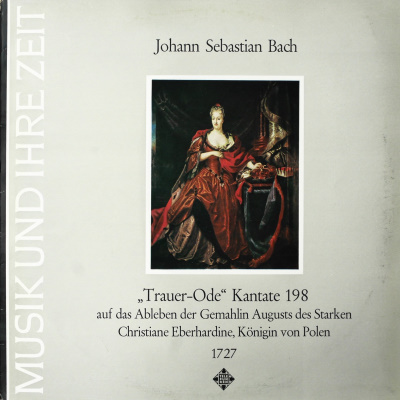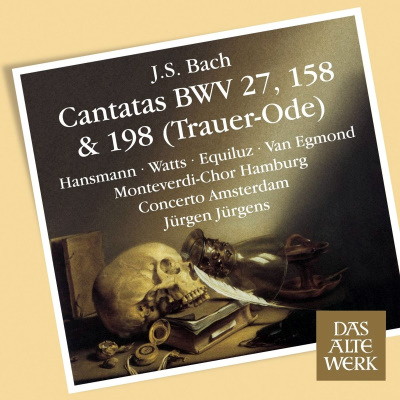 |
|
1 LP -
SAWT 9496-A - (p) 1967
|
 |
| 1 CD -
2564-64673-2 - (c) 2013 |
|
KANTATE
|
|
|
|
|
|
|
|
| Johann Sebastian
BACH (1685-1750) |
Kantate
"Laß Fürstin, laß noch einen Strahl",
BWV 198 - Leipzig 17. Oktober 1727 |
|
35' 19" |
|
|
Trauer-Ode
auf das Ableben der Gemahlin Augusts des
starken - Christiane Eberhardine, Königin
vol Polen und Kurfürstin von Sachsen
für Sopran, Alt, Tenor, Baß, Chor, 2
Traversflöten, 2 Oboen d'amore, 2
Lauten, Violinen I und II, Bratschen, 2
Violen da gamba, Continuo (Vcl.,
Violone, Cembalo e Organo) |
|
|
|
|
Erster Teil
|
|
23' 30"
|
|
|
- Coro: "Laß, Fürstin, laß noch
einen Strahl"
|
6' 11" |
|
A1 |
|
-
Recitativo (Sopran): "Dein Sachsen, dein
bestürztes Meißen" |
1' 15" |
|
A2 |
|
-
Aria (Sopran): "Verstummt, ihr holden
saiten"
|
4' 04" |
|
A3 |
|
-
Recitativo (Alt): "Der Glocken bebendes
Getön" |
0' 47" |
|
A4 |
|
-
Aria (Alt): "Wie starb die Heldin so
vergnügt" |
7' 46" |
|
A5 |
|
-
Recitativo (Tenor): "Ihr Leben ließ die
Kunst zu Sterben"
|
1' 11" |
|
B1 |
|
-
Coro: "An dir, du Vorbild großer Frauen"
|
2' 16" |
|
B2 |
|
Zweiter Teil
|
|
11' 49" |
|
|
-
Aria (Tenor): "Der Ewigkeit saphirnes
Haus"
|
4' 06" |
|
B3 |
|
-
Recitativo (Baß): "Was Wunder ist's? Du
bist er wert" - Arioso: "So weit der volle
Weichselstrand" |
2' 32" |
|
B4 |
|
-
Coro: "Doch, Königin! du stirbest nicht" |
5' 11" |
|
B5 |
|
|
|
|
|
Rohtraud
Hansmann, Sopran
Helen
Watts,
Alt
Kurt
Equiliz, Tenor
Max
van Egmond, Baß
|
MONTEVERDI-CHOR HAMBURG
CONCERTO AMSTERDAM | Jaap
Schröder, Konzertmeister
Frans Vester, Joost Tromp, Querflöte
Lilian Lagaay, Ad Mater,
Oboe d'amore
Eugen M. Dombois, Gusta
Goldschmidt, Laute
Veronika Hampe, Wielan
Kuijken, Gambe
Gustav Leonhardt, Orgel und
Cembalo
Jürgen JÜRGENS, Gesamtleitung
|
|
|
|
|
|
Luogo
e data di registrazione |
|
Hervormde Kerk,
Bennebroek (Holland) - 9/13 Giugno
1966
|
|
|
Registrazione: live
/ studio |
|
studio |
|
|
Producer |
|
Wolf Erichson
|
|
|
Prima Edizione LP |
|
Telefunken "Das Alte
Werk" | SAWT 9496-A | 1 LP -
durata 35' 19" | (p) 1967 | ANA
|
|
|
Edizione CD |
|
Warner Classics
"Das Alte Werk | LC 04281 |
2564-64763-2 | 1 CD - durata 66'
44" | (c) 2013 | ADD
|
|
|
Cover
|
|
Princess Eberhardine,
Wife of Augustus I, unknown master
of the 18th century.
|
|
|
Note |
|
-
|
|
|
|
|
|
In spite of
the widespread interest in
and knowledge of Bach’s work
nowadays, the “Funeral Ode”
still remains one of the
least known works of this
former Cantor of St. Thomas’
Leipzig. This is
understandable if one
considers the text on its
own - written for a
particular occasion in a
particular age - but not
understandable when one
appreciates what Bach did
with the text.
The work was probably
written in Leipzig in the
short time of two weeks in
October 1727 and was
completed on the 15th of
that month. A month earlier
on the 5th of September 1727
the Electress of Saxony and
Queen of Poland, Christiane
Eberhardine, had died.
Unlike her husband,
Frederick Augustus II, she
had remained a Protestant,
and after his conversion in
1697 withdrew to her Palace
at Pretzsch, near
Wittenberg. As a defender of
her faith she enjoyed the
highest esteem and love in
predominantly Protestant
Saxony and especially in
Leipzig. It was only natural
then that Leipzig should be
the scene of a great
Memorial Service. A student
of noble descent, Carl von
Kirchbach, took the
initiative and extracted
from the Elector the
permission to hold a
University service at which
he intended to make the
funeral oration. Funeral
music was a requisite part
of such a ceremony.
Kirchbach asked no lesser
persons than Gottsched to
write the text and the
Cantor of St. Thomas’ to
compose the music. In making
this request to Bach he
passed over the University
Cantor, Johann Gottlieb
Görner, the person actually
responsible for academical
ceremonies. The latter
promptly tried to get hold
of the commission himself or
at least. to be responsible
for the performance,
however, without success. On
the 17th of October the
bells of all the city
churches tolled as the
procession made its way to
the University Church where
the Memorial Service took
place with great pomp and
ceremony. Bach conducted the
performance of his work from
the harpsichord.
The cantata in the broadest
sense of the word - whether
as the church cantata or the
patrician, academic or
courtly work of musical
homage and festivity -
accompanied the Arnstadt and
Mühlhausen organist, the
Weimar chamber musician and
court organist, the Köthen
conductor and finally the
Leipzig cantor of St.
Thomas’-Bach-all through his
creative life, although with
fluctuating intensity, with
interruptions and
vacillations that still are
problems to musicological
research down to this very
day. The earliest preserved
cantata (“Denn du wirst
meine Seele nicht in der
Hölle lassen”) probably
dates, if it really is by
Bach, from the Arnstadt
period (1704) and is still
completely under the spell
of North and Central German
traditions. In the works of
his Mühlhausen years
(1707-08) - psalm cantatas,
festive music for the
changing of the council and
a funeral work (the “Actus
tragicus”) - we sense for
the first time something of
what raises Bach as a
cantata composer so much
higher than all his
contemporaries: the ability
to analyse even the most
feeble text with regard to
its form and content, to
grasp its theological
significance and to
interpret it out of its very
spiritual centre in musical
“speech” that is infinitely
subtle and infinitely
powerful in effect. In
Weimar (1708-17) new duties
pushed the cantata right
into the background to begin
with. It was not until the
Duke commissioned him to
write “new pieces monthly”
for the court services that
Bach once more turiied to
the cantata during the years
1714-16, on texts written by
Erdmann Neumeister and
Salomo Franck. Barely thirty
cantatas can be ascribed to
these two years with a
reasonable degree of
certainty. It is most
remarkable that, on the
other hand, no courtly
funeral music has been
preserved from the entire
Weimar period, although
there must have been a
considerable demand for such
works. It is conceivable
that many a lost work,
supplied with a new text by
Bach himself, lives on among
the Weimar church cantatas.
In the years Bach spent at
Köthen (1717-23), on the
other hand, it is the
composition of works for
courtly occasions of homage
and festivity that come to
the fore, entirely in
keeping with Bach’s duties
as Court Conductor. It is
only during the last few
months he spent at Köthen
that we find him composing a
series of church cantatas
once again, and these were
already intended for
Leipzig. It was in Leipzig
that the mojority of the
great church cantatas came
into being, all of them -
according to the most recent
research - during his first
few years of office at
Leipzig and comprising
between three and a maximum
of five complete series for
all the Sundays and feast
days of the ecclesiastical
year. But just as suddenly
as it began, this amazing
creative flow, in which this
magnificent series of
cantatas arose, appears to
have ended again. It is
possible that Bach’s regular
composition of cantatas
stopped as early as 1726;
from 1729 at the latest it
is evident that other tasks
largely absorbed his
creative energy,
particularly the direction
of the students’ Collegium
Musicum with its perpetual
demand for fashionable
instrumental music. More
than 50 cantatas for courtly
and civic occasions have
indeed been recorded from
later years, but considered
over a period of 24 years
and compared with the
productivity of his first
years in Leipzig they do not
amount to very much. We are
left with the picture of an
enigmatic silence in a
sphere which has ever
counted as the central
category in Bach’s creative
output.
But we only need cast a
superficial glance at the
more than 200 of the
master’s cantatas that have
come down to us in order to
see that this conception of
their position in Bach’s
total output is fully
justified. Bach has
investigated their texts
with regard to both their
meaning and their wording
with incomparable
penetration, piercing
intellect and unshakeable
faith, whether they are
passages from the Bible,
hymns, sacred poems by his
contemporaries or sacredly
trimmed poetry for courtly
occasions. He has
transformed and interpreted
these texts through his
music with incomparable
powers of invention and
formation, he has revealed
their essence and, at the
same time, translated the
imagery and emotional
content of each to their
ideas into musical images
and emotions. The perfect
blending of word and note,
the combination of idea
synthesis and depiction of
each detail of the text, the
joint effect of the baroque
magnificence of the musical
forms and the highly
differentiated attention to
detail, the skillful balance
between contrapunctal,
melodic and harmonic means
in the service of the word
and, not least, the
inexhaustible fertility and
greatness of a musical
imagination that is able to
create from the most feeble
‘occasional’ text a world of
musical characters - all
this is what raises the
cantata composer Bach so
much higher than his own and
every other age and their
historically determined
character, and imparts a
lasting quality of his
works. It is not their texts
alone and not their music
alone that makes them
immortal - it is the
combination of word and note
into a higher unit, into a
new significance that first
imparts to them the power of
survival and makes them what
they are above all else:
perfect works of art.
|
  |
|
|